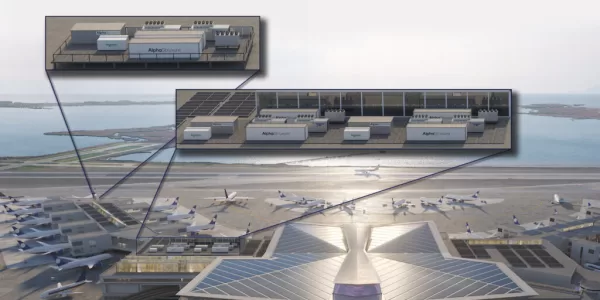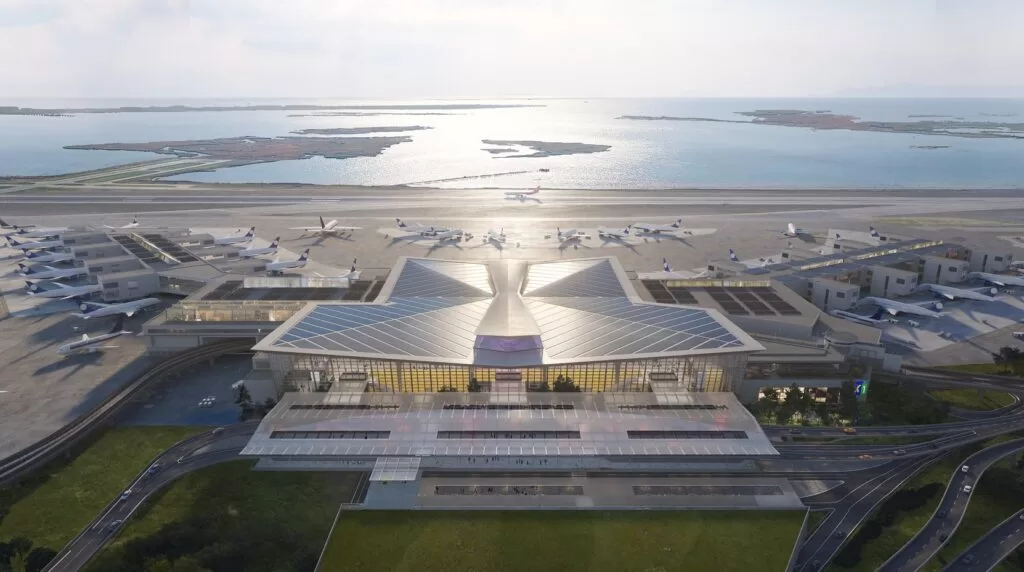A 12MW microgrid featuring solar power, fuel cells, and battery energy storage is in the works at JFK Airport’s New Terminal One. According to airport and project officials, this microgrid can power half of the terminal’s daily operations.
Construction has begun on a solar array of more than 13,000 solar panels on John F. Kennedy International (JFK) Airport’s new Terminal One, part of a 12MW microgrid.
The 6.63MW solar array on the terminal’s roof forms part of a 12MW microgrid that will distribute electric energy from solar, fuel cells and batteries through a localized and self-contained energy system. This system can operate independently from or connected to the main power grid. The microgrid will also include 3.84MW of fuel cells and 1.5MW/3.34MW/h of battery energy storage. Four clusters of electrical generation infrastructure placed around the new terminal will create a single smart, resilient energy system, providing power for the terminal’s daily operations.
The New Terminal One rooftop solar canopy will be the largest at any U.S. airport
The New Terminal One rooftop solar canopy will become the largest such solar array at any U.S. airport. It will provide a valuable case study for both the aviation and solar energy industries due to federal requirements to mitigate glare. The unique design of the clustered power islands may also serve as a case study for other airports with limited space or busy operations but wanting to add scalable on-site green power generation.
The microgrid will recover heat from the fuel cells to generate chilled water and hot water for the terminal. Its capacity generates enough electricity to power half of the everyday operations of the terminal, or roughly the energy to power more than 3,500 average U.S. homes. AlphaStruxure will finance the microgrid project through an Energy as a Service (EaaS) contract, a long-term agreement ensuring predictable operating costs and guaranteed performance without upfront capital expenditures to neither the Port Authority nor New Terminal One. AlphaStruxure will take responsibility for the construction, operation and maintenance of the microgrid over the life of the contract.
Rick Cotton, executive director at the port authority, stated, “When we complete the new terminal, it will become the largest terminal at JFK Airport, so we particularly welcome incorporating on-site power using a green energy source into the terminal’s design. We have prioritized sustainability at our facilities, and this massive solar array offers a unique and innovative solution that reduces our carbon footprint and continues our march toward net zero.”
Read also: Michigan’s newest solar project: 360 MW Sunfish Solar 2
Port Authority’s aggressive sustainability goals
The clean technology aligns with the Port Authority’s aggressive sustainability goals, which include reaching net-zero emissions by 2050 and requiring greener operations by its business partners, such as airport terminal operators and airlines. The Port Authority, in partnership with the New York Power Authority, is also constructing a 12-megawatt solar canopy at JFK’s long-term parking lot 9. This will consist of 7.5 megawatts of battery storage for airport peak energy use and a 6-megawatt community solar generation facility, as well as provide covered parking for 3,000 vehicles.
Other solar projects at Port Authority facilities include a 5-megawatt solar parking canopy at Newark Liberty International Airport, a 1.5-megawatt rooftop solar array on LaGuardia Airport’s Terminal B garage, and a 600-kilowatt solar roof on a PATH warehouse rooftop.

JFK’s New Terminal One Microgrid
The New Terminal One microgrid will offer exceptional resilience due to its novel design of clustered architecture consisting of four so-called power islands. Each power island functions as a hyper-localized, self-sufficient energy system with sources of generation, storage, and advanced automation and control. When operators take one island down for routine maintenance, the other three can remain online. The microgrid’s ability to provide half of the terminal’s own electrical needs helps to mitigate the impact of a regional grid blackout on airport operations, which could lead to substantial delays for airline passengers.
Read also: Constable Solar a 3.6Mw agrivoltaic solar project in New York
Project Partners
Project partners include AlphaStruxure‘s two parent companies, Schneider Electric and Carlyle. Schneider will deliver leading microgrid technology, controls, software, and services, while Carlyle will provide financing for the microgrid. Other project partners include Burns, serving as owner’s engineer on the project; E-J Electric Installation Co. as the design-builder; Vanderweil Engineers as the engineer of record; BOND Civil & Utility Construction as the mechanical contractor; and HyAxiom, a Doosan company, as the provider of fuel cells and their maintenance.
Construction of the microgrid will support almost 100 local jobs, through AlphaStruxure’s design-builder partner E-J Electric Installation Co. Headquartered in Queens, E-J Electric will source all labor through local unions affiliated with the Building and Construction Trades Council of Greater New York.
Port Authority Chairman Kevin O’Toole said, “This construction milestone in our redevelopment of John F. Kennedy International Airport represents more than progress at one of our facilities because its success will set an industry example for others. On-site green energy development such as the country’s largest airport solar array will reduce the generation of greenhouse gases that cause climate change at the New Terminal One.”
Read also: How Much Does A Home Solar System Cost? A Detailed Guide For Homeowners

JFK Airport’s New Terminal One Microgrid Project Factsheet
Project Overview:
Construction of a 12MW microgrid at JFK’s New Terminal One
To feature largest airport solar array in the United States
Solar Array Specifications:
More than 13,000 solar panels
6.63MW capacity
Rooftop installation on New Terminal One

Microgrid Components:
Total capacity: 12MW
Solar array: 6.63MW
Fuel cells: 3.84MW
Battery energy storage: 1.5MW/3.34MWh
Four distributed power island clusters
Read also: World’s largest solar power plant commences in Australia

